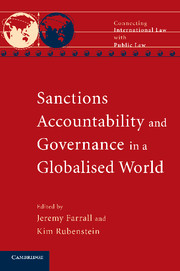Book contents
- Frontmatter
- Contents
- Contributors
- Series editors' preface
- Editors' preface
- Introduction: Filling or falling between the cracks? Law's potential
- PART I Setting down the foundations
- 1 Whose public? Which law? Mapping the internal/external distinction in international law
- 2 The potential for a post-Westphalian convergence of ‘public law’ and ‘public international law’
- PART II Internationalising public law
- PART III Implementing Security Council sanctions
- PART IV The place of corporations
- PART V The role of lawyers
- PART VI Public law and public policy
- PART VII Parallel case studies
- Concluding remarks
- Bibliography
- Index
1 - Whose public? Which law? Mapping the internal/external distinction in international law
Published online by Cambridge University Press: 05 October 2010
- Frontmatter
- Contents
- Contributors
- Series editors' preface
- Editors' preface
- Introduction: Filling or falling between the cracks? Law's potential
- PART I Setting down the foundations
- 1 Whose public? Which law? Mapping the internal/external distinction in international law
- 2 The potential for a post-Westphalian convergence of ‘public law’ and ‘public international law’
- PART II Internationalising public law
- PART III Implementing Security Council sanctions
- PART IV The place of corporations
- PART V The role of lawyers
- PART VI Public law and public policy
- PART VII Parallel case studies
- Concluding remarks
- Bibliography
- Index
Summary
a. A violent order is a disorder; and
b. A great disorder is an order. These
Two things are one.
– Wallace StevensIntroduction
The chapters in this volume address different aspects of the same basic dilemma: how to understand the conceptual relationship between the rights of states and the rights of individuals. Classic Westphalianism offers a relatively clear picture. The fundamental rights and duties of states, regardless of their ‘private’ belief systems, forms of political organisation or cultures, are to be determined by that body of customary and consensual norms known as ‘public’ international law. The fundamental rights and duties of individuals, regardless of their ‘private’ comprehensive religious, philosophical or moral doctrines, are to be determined by that body of constitutional, administrative and criminal norms known as ‘public’ law. The former defines the ‘sovereignty’ of states as subjects of an international community; the latter defines the ‘liberty’ of individuals as subjects of a national community in the form of a state.
In each case a particular distinction between ‘public’ and ‘private’ spheres, and a particular conception of fundamental rights, is advanced. These approaches in turn generate the distinctive internal/external dichotomies and contradictions that characterise both fields of law. It is critical to realise at the outset, however, that the underlying rationale of the move to ‘public law’, whether domestic or international, is to establish the conditions necessary for community and social order by limiting the freedom of legal subjects.
- Type
- Chapter
- Information
- Publisher: Cambridge University PressPrint publication year: 2009



